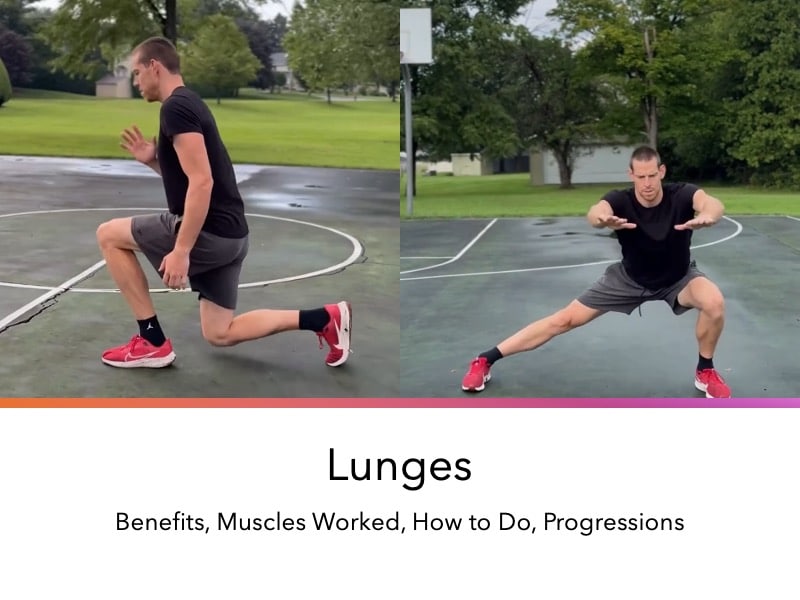Lunges: Benefits, Muscles Worked, How to Do, Variations
Lunges are one of the most effective leg exercises for building strength, stability, and muscle balance in the lower body.
They train multiple muscle groups at once, including the glutes, quads, hamstrings, calves, and even core, making them a foundational movement in both athletic training and everyday fitness routines.
Whether you’re performing reverse lunges, lateral lunges, jump lunges, or any other lunge variation, this versatile exercise develops unilateral strength, corrects muscle imbalances, and improves mobility.
Lunges also train essential movement patterns, such as hip extension, knee stability, and single-leg control, which are crucial for injury prevention and performance enhancement.
For beginners asking “what are lunges” or more advanced individuals wondering “how to do lunges with weights,” this guide will help you understand the full range of benefits that lunges provide, and how to master them for long-term results!
What Are Lunges?
Lunges are a lower body strength-training exercise that involves stepping forward, backward, or sideways into a split stance and lowering your hips toward the ground.
The goal is to bend both knees to about 90 degrees while keeping your torso upright and your core engaged.
Unlike bilateral exercises like squats, lunges are a unilateral movement (single-leg exercise), meaning they train one leg at a time.
This makes them excellent for improving muscular balance, hip stability, and functional strength, which can be directly translated into sports performance and daily movement.
Lunges are widely considered one of the most effective leg exercises because they target the glutes, quads, hamstrings, and calves simultaneously, while also challenging coordination and balance.
Whether you’re doing forward lunges, reverse lunges, or side lunges, this exercise can be adapted to suit beginners and advanced athletes alike, and performed using just your bodyweight or with added resistance like dumbbells, kettlebells, or barbells.
How to Do Lunges (Step-by-Step)
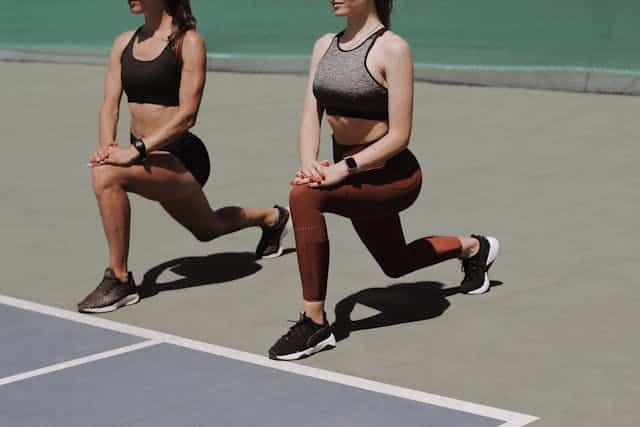
There are many types of lunges (forward, reverse, side, curtsy, jumping, and more), and each lunge variation serves a slightly different purpose.
While the mechanics can vary, they all build lower body strength, challenge balance, and improve functional movement.
Below, you’ll find instructions for the basic forward lunge, which serves as a foundational movement for nearly all other lunge variations.
Mastering this version will help you understand the form, posture, and technique required to perform any lunge safely and effectively.
Step-by-Step Instructions for a Basic Forward Lunge:
- Start Position: Stand tall with your feet hip-width apart, shoulders back, and core engaged.
- Step Forward: Take a big step forward with your right leg, landing with your heel and keeping your chest upright.
- Lower Into Lunge: Bend both knees to about 90 degrees. Your back knee should hover just above the floor, and your front thigh should be parallel to the ground.
- Push Back to Start: Press through your front heel to return to the starting position with control.
- Repeat: Alternate legs for each repetition or perform all reps on one side before switching.
Key Form Tips:
- Keep your front knee aligned over your ankle.
- Avoid letting your torso tip forward or your back arch excessively.
- Brace your core to improve balance and stability.
Mistakes to Watch Out For:
- Letting the front knee collapse inward or track far past the toes.
- Narrow stepping, which can throw off balance.
- Allowing the front heel to lift.
What Muscles Do Lunges Work?
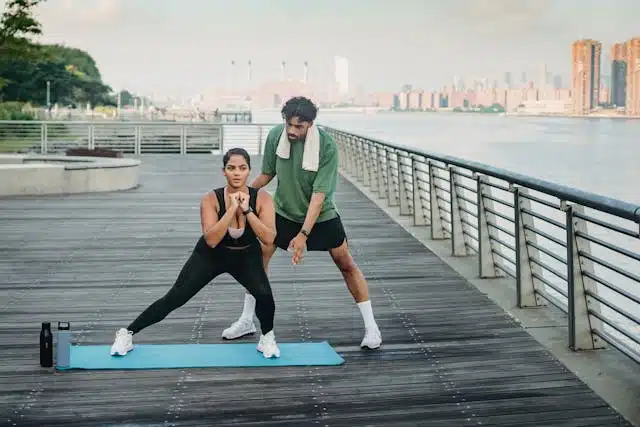
Lunges are one of the most effective compound exercises for targeting the major muscles of the lower body, along with important stabilizers and core muscles.
Because lunges are a unilateral movement, they also help correct muscular imbalances and promote symmetrical strength.
Primary Muscles Worked:
- Quadriceps: The front thigh muscles are heavily activated, especially in forward and walking lunges.
- Glutes: Lunges recruit the gluteus maximus to extend the hip and stabilize the pelvis, especially in reverse, curtsy, and lateral lunges.
- Hamstrings: These posterior thigh muscles assist with hip extension and help decelerate movement during the lowering phase.
- Adductors: Lateral and curtsy lunges target the inner thighs to improve hip stability and side-to-side strength.
- Calves (Gastrocnemius & Soleus): Support ankle stability and balance as you move through the lunge motion.
- Core (Abs & Obliques): Help maintain posture and balance by stabilizing the spine throughout each rep.
Secondary Muscles Activated:
- Hip Flexors: Especially active during forward lunges when stepping out or returning to the starting position.
- Spinal Erectors: Work to maintain an upright torso and protect your lower back during loaded variations.
By regularly incorporating different lunge variations into your workouts, you can develop balanced strength across all major lower-body muscle groups while improving mobility, control, and functional fitness.
How Many Lunges Should I Do?
The number of lunges you should do depends on your fitness goals, current level of experience, and the variation you’re performing. Whether you’re a beginner or an advanced athlete, lunges can be easily adjusted for intensity, volume, and progression.
General Guidelines:
- Beginners: Start with 2-3 sets of 8-10 lunges per leg to build proper form and strength. Focus on mastering technique before increasing volume.
- Intermediate: Perform 3-4 sets of 12-15 lunges per leg. At this stage, you can start incorporating added weight or more challenging lunge variations (e.g., lateral lunges or jumping lunges).
- Advanced: Aim for 4-5 sets of 15-20 lunges per leg or more. Advanced trainees can incorporate high-intensity variations like jump lunges or Bulgarian split squats to further challenge strength, endurance, and explosive power.
Training Frequency:
- For strength-building: Include lunges in your routine 2-3 times per week, allowing at least 48 hours of rest in between sessions to promote muscle recovery.
- For endurance and conditioning: If you’re focusing on endurance, you might aim for higher repetitions (20+ per leg), performing lunges more frequently, such as 3-4 times per week.
Progressing Over Time:
As you get stronger, you can increase the number of reps, sets, or the amount of weight you use to ensure continued progress.
Always listen to your body, especially if you experience joint discomfort or excessive fatigue.
Most Common Lunge Variations
Once you’ve mastered the basic lunge, incorporating different lunge variations is the key to continued progress.
Different types of lunges emphasize different muscle groups, movement planes, and stability demands, making your workouts more dynamic and well-rounded.
Whether your goal is to build strength, improve balance, increase mobility, or prevent injuries, the lunge variations below will help you target your lower body from every angle.
These movements can be adapted for beginners or made more challenging for advanced training.
Reverse Lunge
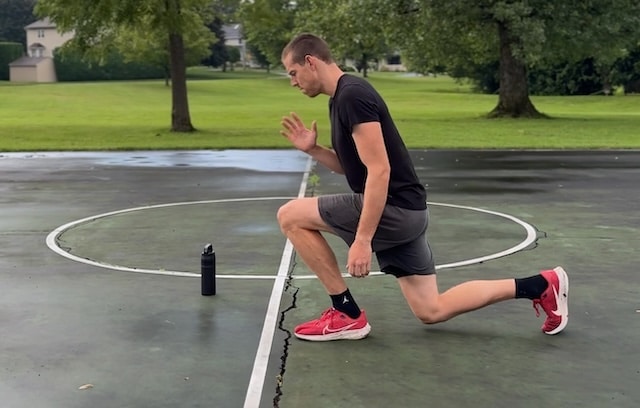
The reverse lunge is often considered the best starting point for those new to lunges.
Unlike the forward lunge, where you step forward, the reverse lunge involves stepping backward (simple, right?).
This movement places less stress on the knee joint, particularly on the patellar tendon, making it a safer option for beginners or those with knee concerns (Comfort et al., 2015).
The reverse lunge primarily works the quadriceps, glutes, and hamstrings, helping you build a strong foundation of lower body strength.
It is one of the best quad exercises and an excellent overall exercise for building a strong, stable, and healthy lower body.
How to Do a Reverse Lunge:
- Stand with your feet hip-width apart.
- Take a step back with your right foot, lowering your hips until both knees are bent at a 90-degree angle.
- Push through your left heel to return to the starting position.
- Repeat on the other side.
Muscles Worked: Quadriceps, glutes, hamstrings.
Forward Lunge
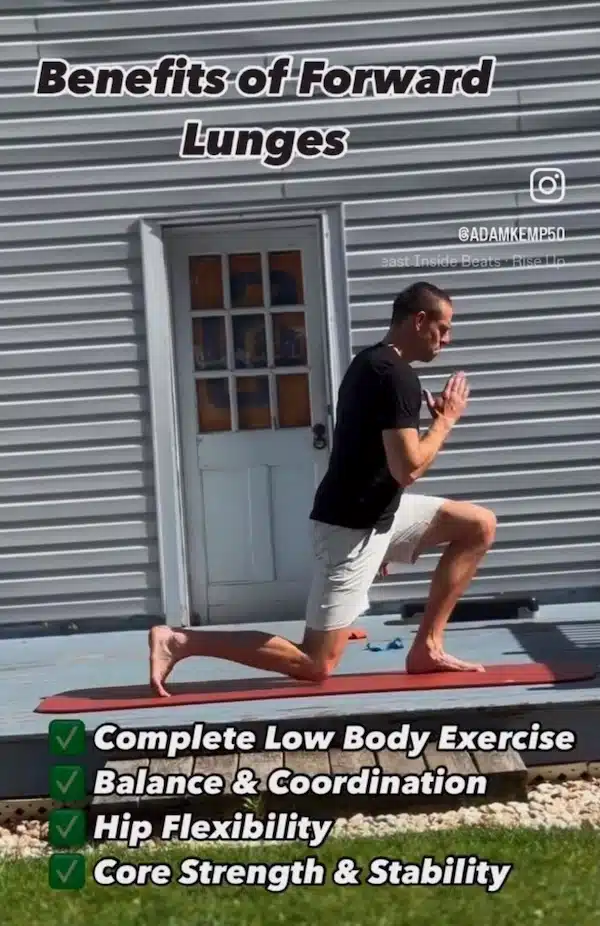
Once you’ve mastered the reverse lunge, the forward lunge is the next logical progression.
The forward lunge requires you to step forward, which increases the load on your front leg, particularly the quadriceps and glutes.
This lunge variation also challenges your balance and coordination, as you must control your body weight as you move forward.
The forward lunge is a great exercise for improving lower body strength and stability, and it can be easily modified by adding weights or increasing the step length.
How to Do a Forward Lunge:
- Stand with your feet hip-width apart.
- Take a large step forward with your right foot, lowering your hips until both knees are bent at about 90 degrees.
- Push through your right heel to return to the starting position.
- Repeat on the other side.
Muscles Worked: Quadriceps, glutes, hamstrings, calves.
Lateral Lunge
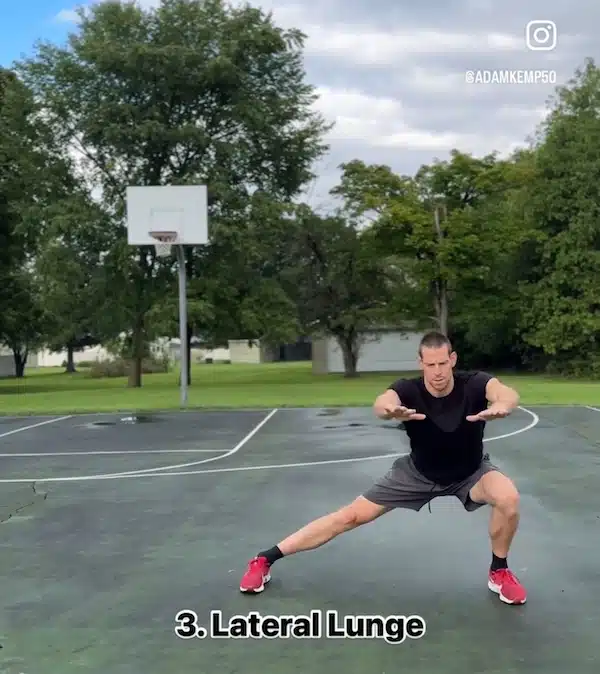
Lateral lunges (also known as side lunges) add a new dimension to your workout by introducing side-to-side movement, which is often neglected in traditional lower-body exercises.
This variation targets the adductors (inner thigh muscles) and glutes, making it ideal for improving hip mobility and strengthening the muscles that support lateral movements.
Research shows that side lunges produce significantly greater patellofemoral joint force and stress than forward lunges, especially at deeper knee flexion angles between 40° and 100°, which means they demand more control and stability from the quadriceps, glutes, and surrounding joint stabilizers (Escamilla et al., 2022).
Incorporating lateral lunges into your routine can help improve your agility, balance, and overall athletic performance, especially in sports that require quick side-to-side movements.
How to Do a Lateral Lunge:
- Stand with your feet hip-width apart.
- Take a big step to the right, bending your right knee and pushing your hips back as you lower into a lunge.
- Keep your left leg straight and your chest up.
- Push through your right heel to return to the starting position.
- Repeat on the other side.
Muscles Worked: Glutes, adductors, quadriceps, hamstrings.
Curtsy Lunge
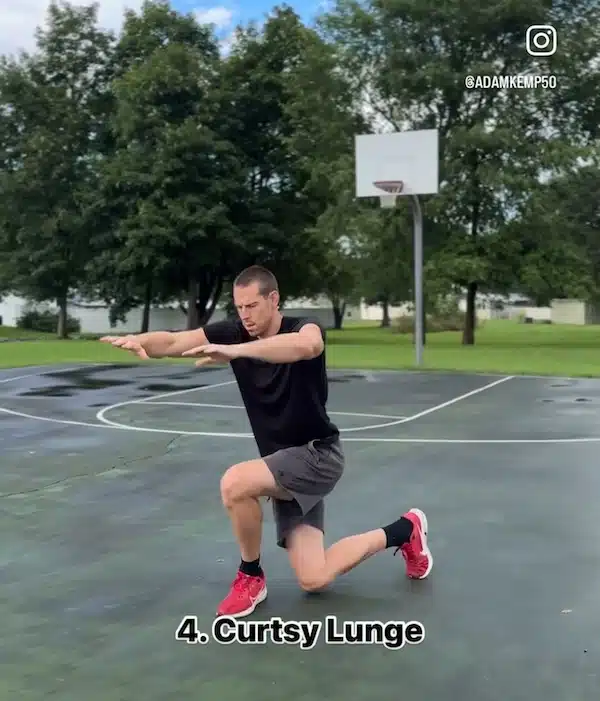
The curtsy lunge is the most advanced of the lunge variations discussed here. By stepping your leg diagonally behind you, the curtsy lunge places a unique demand on your glutes, quads, and inner thighs.
This lunge variation not only challenges your balance and coordination but also requires significant lower-body strength to perform correctly.
The curtsy lunge is an excellent finishing move for a lower body workout, helping to develop the smaller stabilizing muscles that are often overlooked in traditional exercises.
How to Do a Curtsy Lunge:
- Stand with your feet hip-width apart.
- Step your right leg diagonally behind your left leg, lowering your hips until your left thigh is nearly parallel to the floor.
- Keep your chest up and your weight centered over your left leg.
- Push through your left heel to return to the starting position.
- Repeat on the other side.
Muscles Worked: Glutes, quadriceps, adductors, hamstrings.
Seesaw Lunge
The seesaw lunge is a dynamic lunge variation that combines a forward and reverse lunge into one continuous movement.
This challenges your ability to shift weight smoothly between legs while maintaining balance and core control.
By alternating between forward and backward lunges on the same leg, you improve coordination, muscular endurance, and joint stability—especially in the hips, knees, and ankles.
The seesaw lunge is great for developing unilateral strength and increasing time under tension, making it ideal for both strength-building and conditioning workouts.
How to Do a Seesaw Lunge:
- Stand with your feet hip-width apart.
- Step your right leg forward into a lunge, lowering your hips until both knees are bent to 90 degrees.
- Push through your right heel to return to center, then immediately step your right leg backward into a reverse lunge.
- Drive through your left heel to return to the starting position.
- Repeat all reps on one side before switching legs.
Muscles Worked: Quadriceps, glutes, hamstrings, calves, core.
Additional Types of Lunge Progressions & Variations
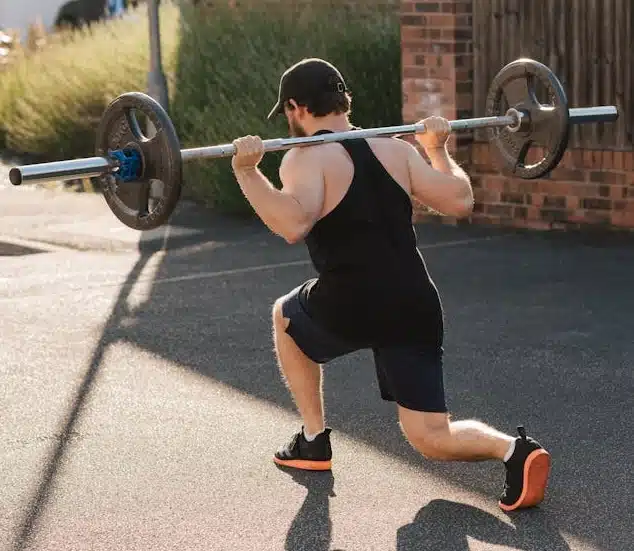
Once you’ve mastered the basic lunge variations, there are several ways to increase the difficulty and continue challenging your muscles.
By adding weight, incorporating different equipment, or modifying your technique, you can make lunges more intense and effective.
Here are some strategies to elevate your lunges:
Walking Lunges
Walking lunges are a highly functional variation that involve continuous forward movement rather than staying in place.
Unlike stationary lunges, where you return to the starting position after each rep, walking lunges require you to step forward with alternating legs, challenging your balance, coordination, and lower-body strength in a more dynamic way.
This forward momentum increases time under tension and mimics real-life movement patterns, making walking lunges especially valuable for athletes and anyone training for improved gait mechanics, sports performance, or functional mobility.
How to Do Walking Lunges:
- Stand tall with your feet hip-width apart.
- Step forward with your right leg, lowering into a lunge until both knees are at 90 degrees.
- Push off your back foot and bring your left leg forward into the next lunge without pausing in the middle.
- Continue alternating legs, walking forward in a straight line with control.
Equipment Options:
- Bodyweight: Perfect for beginners or high-rep conditioning sets.
- Dumbbells: Hold a dumbbell in each hand at your sides to add resistance and increase muscle activation.
- Kettlebells: Use a kettlebell in a goblet position or hold two by your sides for a similar effect to dumbbells. You can also hold a kettlebell overhead for a more advanced challenge.
- Barbell: Place a barbell across your upper back to challenge your core and total-body stability. This variation is more advanced and demands strict form.
- Medicine Ball: Hold a medicine ball like a goblet or overhead for a unique challenge.
Muscles Worked: Glutes, quadriceps, hamstrings, calves, core.
Walking lunges are ideal for building muscular endurance, increasing unilateral leg strength, and improving athletic movement patterns.
They also pair well with hill sprints, prowler sled pushes, or step-ups in lower-body-focused training sessions.
Weighted Lunges with Dumbbells, Kettlebells, and Barbells
One of the most straightforward ways to increase the difficulty of lunges is by adding weight.
Incorporating dumbbells, kettlebells, or a barbell into your lunges not only increases the resistance but also engages your core and stabilizing muscles more effectively.
- Dumbbell Lunges: Hold a dumbbell in each hand, letting them hang by your sides as you perform your lunge variations. This added resistance forces your muscles to work harder, leading to greater strength gains.
- Kettlebell Lunges: You can hold a kettlebell in one hand or both hands at chest level (in a goblet position). The uneven load of a single kettlebell will challenge your balance and core stability.
- Barbell Lunges: Place a barbell across your shoulders as you lunge. This variation requires significant core strength and stability to maintain proper form throughout the movement.
Tip: Start with lighter weights to ensure you maintain proper form, then gradually increase the load as your strength improves.
Slide Lunges
Slide lunges, also known as gliding lunges, involve using a sliding disc, towel, or paper plate to glide one foot across the floor as you perform the lunge.
This variation adds an extra challenge by requiring more control and stability, particularly from your core and inner thigh muscles.
- Reverse Slide Lunge: Place one foot on a sliding disc and perform a reverse lunge, allowing the disc to glide backward as you lower into the lunge. This variation emphasizes the eccentric (lengthening) phase of the movement, which is crucial for building strength and muscle control.
- Lateral Slide Lunge: Stand with one foot on a sliding disc and perform a lateral lunge, letting the disc slide out to the side as you lower your hips. This movement places a greater emphasis on your adductors and glutes, challenging your ability to control the movement laterally.
Tip: Keep the movement slow and controlled to maximize the engagement of stabilizing muscles and prevent injury.
Jump Lunges
Jump lunges are a plyometric variation that adds an explosive element to your workout. This variation increases the intensity by incorporating a jump between lunges, which boosts your heart rate and engages fast-twitch muscle fibers.
How to Do Jump Lunges:
- Start in a lunge position with one foot forward and one foot back.
- Jump into the air, switching legs mid-air so that you land in a lunge position with the opposite leg forward.
- Immediately jump again, alternating legs with each rep.
Tip: Focus on landing softly to protect your joints and ensure proper form.
Lunge-Combo Exercises
For an even greater challenge, you can combine lunge variations with other exercises to create compound movements that engage multiple muscle groups simultaneously.
- Lunge to Bicep Curl: Perform a lunge while simultaneously curling dumbbells up to your shoulders. This combination works your lower body and arms together.
- Lunge to Shoulder Press: Combine a lunge with an overhead press to engage your lower body, core, and shoulders in one fluid movement.
- Lunge to Row: Pair a reverse lunge with a bent-over row to target your back and legs at the same time.
- Lunge-Step Up: Perform a reverse lunge and then go directly into a step up. This is a great burner for your quads and also helps improve coordination and proprioception for added force-power transfer training.
Note: These compound movements are excellent for time-efficient workouts, as they engage multiple muscle groups and improve overall coordination.
Deceleration Lunges
The deceleration lunge is a powerful lunge variation designed to improve control, joint stability, and athletic movement efficiency.
Unlike traditional lunges that focus on the concentric (lifting) portion, the deceleration lunge emphasizes the eccentric phase, where you slow your body down and absorb force during the landing.
This variation is especially valuable for athletes, as it mimics real-world movement patterns like cutting, jumping, and sprinting.
It strengthens the muscles and connective tissues involved in force absorption, which helps reduce the risk of injury during rapid directional changes.
How to Do a Deceleration Lunge:
- Stand tall with your feet hip-width apart.
- Step forward quickly with your right leg, landing in a controlled lunge position.
- Focus on braking your momentum as you lower your hips, keeping your front knee aligned over your ankle.
- Pause briefly at the bottom, then return to the starting position with control.
- Repeat on the other leg.
Tip: Think of this as a “controlled fall” where your goal is to land softly and stop your body without letting it collapse into the movement.
Muscles Worked: Quadriceps, glutes, hamstrings, calves, core (with heightened emphasis on eccentric control and joint stabilization).
Deceleration lunges are especially effective in knee injury prevention programs, return-to-sport rehab, or as a progression for athletes needing more reactive strength and control.
Final Thoughts: Benefits of Lunges
Lunges are one of the most effective and versatile lower-body exercises you can include in your training.
They improve muscular strength, mobility, coordination, and balance, all while targeting key muscle groups like the glutes, quads, hamstrings, and core.
By incorporating a variety of lunge variations into your routine, such as forward, reverse, lateral, curtsy, walking, or seesaw lunges, you can build functional strength, correct imbalances, and challenge your body in multiple planes of motion.
As one of the most effective bodyweight exercises, lunges require no equipment yet deliver powerful results for building strength, stability, and functional movement.
To take lunges beyond bodyweight exercises, you can add resistance using dumbbells, kettlebells, a barbell, resistance bands, or weighted vests.
These variations increase the training stimulus, help build more muscle and strength, and allow you to progress as your fitness level improves.
Whether you’re training for general fitness, athletic performance, or injury prevention, lunges offer scalable benefits for every fitness level.
Frequently Asked Questions
Read Next: Best Bodyweight Leg Exercises

